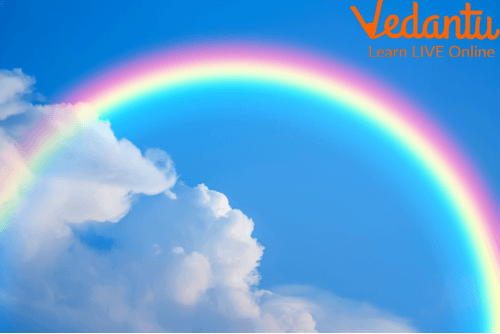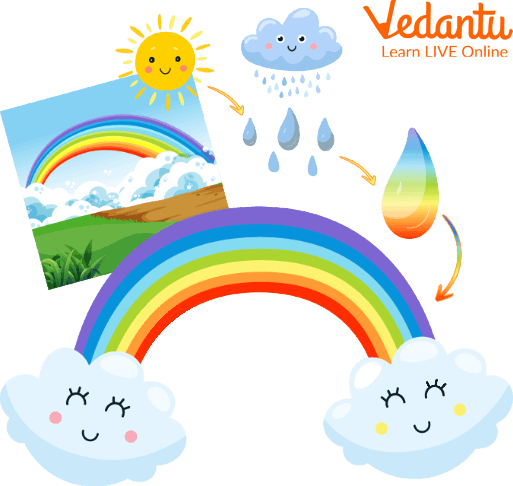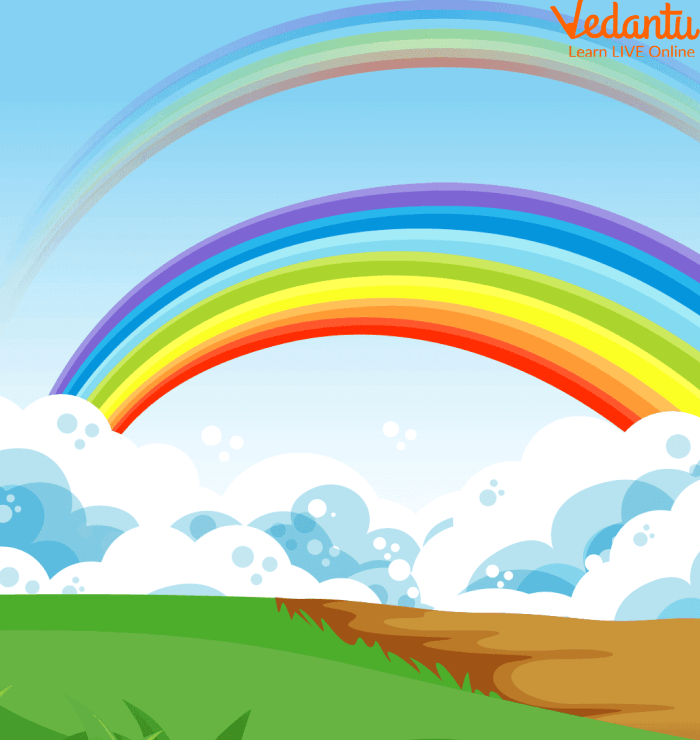




Introduction to Rainbow
Have you ever seen a combination of colours in the sky after rain? That’s your call “ Rainbow ”. It generally appears after the rain with the sun. The Rainbow has seven colours in it. Let’s gather further information about the conformation of the rainbow in it and start with “ Rainbow ”.
What is Rainbow?
A rainbow is a shaft of colour that appears in the sky after rain when the sun shines.
From one end of the world to the other, the rainbow forms a semicircle in the sky.
A rainbow is made up of seven different colours: violet, indigo, blue, green, yellow, orange, and red.

Rainbow Diagram
The Rainbow is originally discovered by the physicist Isaac Newton, who started a series of trials with a prism and the sun that helped him to discover the rainbow, which is made up of seven different colours.
How is a Rainbow Formed?
Rainbows are created when the sun is scattered by water driblets( similar to drops or fog) in a process known as refraction.
When the sun passes through a medium-thick than air, similar to a droplet, it refracts, changing its direction. When light enters the droplet, it's refracted, reflected off the reverse, and also refracted again as it escapes and travels to our eyes.
Colours in Rainbow
The sequence of the rainbow is made out of seven colours and no changes occur. The sequence of the seven colours of the rainbow is red, orange, pusillanimous, green, blue, indigo, and violet( it is from top to bottom). In short, it is called VIBGYOR.
Some of the light that strikes a raindrop is reflected. The electromagnetic diapason is made up of light swells of colourful wavelengths that are reflected at colourful angles.
As a result, the spectrum is split, resulting in a rainbow.

Rainbow Formation
Types of Rainbow
There are two types of the rainbow: Primary rainbow and Secondary rainbow
1. Primary Rainbow
It undergoes only one internal reflection.
It is brighter than a secondary rainbow.
Order of colour is maintained. (From bottom to top = violet, indigo, blue, green, yellow, orange, and red)
2. Secondary Rainbow
It undergoes two internal reflections.
It is fainter than a primary rainbow.
The order of colour is reversed.

Primary and Secondary Rainbow
When Do You See a Rainbow?
When the sun is behind us and rain is falling in front of us, the rainbow is seen. When the sun meets a falling drop of water, the water's face refracts it, changing its direction. The light passes through the drop and is reflected from the reverse to the front.
When there are water drops in the air with the sun beaming from behind the bystander at a low height angle, rainbows can be seen. As a result, rainbows are most generally observed in the morning in the western sky and in the early evening in the eastern sky.
Facts about Rainbow
1. A rainbow is a multi-coloured arc in the sky that emerges when it rains.
2. Rainbow is seen in a semi-circle shape on the ground, but it is seen in a full circle from an aeroplane.
3. You can't touch a rainbow since it has no physical form!
4. Rainbows are only conceivable on Earth, the only planet in the solar system.
5. Hawaii is home to the world's largest number of rainbows.
Summary
Rainbows are created when the sun is scattered by water driblets( similar to drops or fog) in a process known as refraction. When the sun passes through a medium-thick than air, similar to a droplet, it refracts, changing its direction. When light enters the droplet, it's refracted, reflected off the reverse, and also refracted again as it escapes and travels to our eyes.
FAQs on How is a Rainbow Formed?
1. How many colours are present in a rainbow and what are the seven colours of a rainbow?
Seven colours are present in a rainbow. The sequence of the rainbow is made out of seven colours. The sequence of the seven colours of the rainbow is red, orange, unheroic, green, blue, indigo, and violet (it is from top to bottom) and violet, indigo, blue, green, unheroic, orange, and red (this sequence is from bottom to top). Both the sequence is seen together in a double rainbow (primary and secondary rainbow).
2. How is a rainbow formed?
Rainbows are formed when light shines through the water. When the sun meets a falling drop of water, the water's face refracts it, changing its direction. The light passes through the drop and is reflected from the reverse to the front. The light is fraudulent and reflected, frequently leading to the confirmation of the colours of the rainbow. The electromagnetic dispersion is made up of light swells of colourful wavelengths that are reflected at colourful angles. As a result, a rainbow is formed.
3. What is a full rainbow?
A rainbow is created when raindrops and sunshine combine to form a circle of light in the sky. However, it's a pretty uncommon sight. The sky has to be just right for this to happen, and even then, your horizon will usually obstruct the bottom half of a full-circle rainbow.









